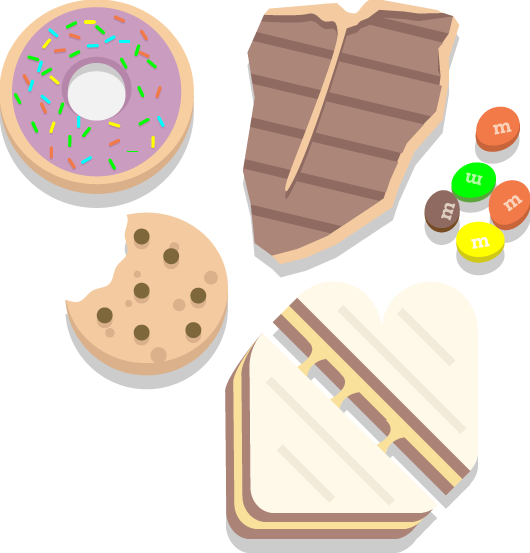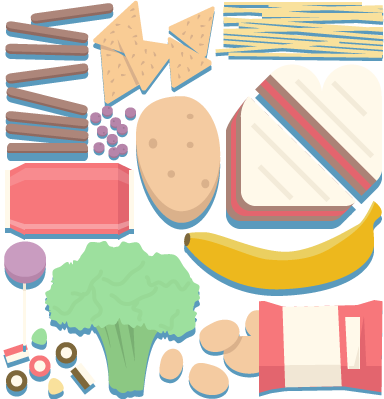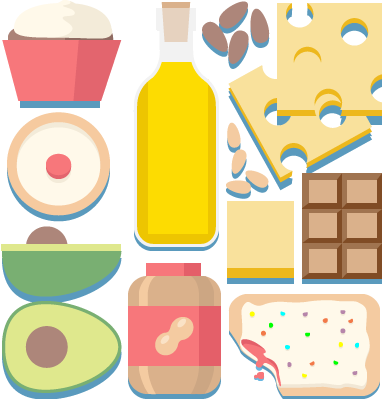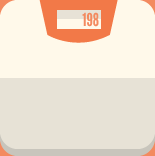Flexible dieting, simply put, is the tracking of protein, carbohydrate and fat to change your body composition.
Flexible dieting is designed to fit around your lifestyle and preferences. You can go for a meal with loved ones, or enjoy that treat that you crave, without worrying about going off track, as long as foods fit within your daily macronutrient and calorie goals. Flexible dieting helps to create a healthy relationship with food and takes the worry out of dieting. There's no 'cheating' or eating the 'wrong' or 'dirty' foods. Without the guilt, there's less stress and fewer urges to binge or get off track!
How is flexible dieting different to traditional diets? Well, very low calorie diets often created by the removal of entire macronutrients (carb-free diets such as Atkins, and the traditional low-fat diet) mean that weightloss will occur in the short term, but when cravings and real life kicks in, weight is almost always gained back. Flexible dieting also plans for the long-term, and the months and years after a lower calorie diet, ensuring that you can recover and keep the weight off!


Carbohydrates, make up the bulk of most diets. Sugar is often avoided in fixed diet plans, but is not something to be worried about when flexible dieting. You should aim to include several portions of fruit and fibrous vegetables each day.

Protein is used for maintainance and growth in the body, particularly for muscle. Protein is normally a low priority in traditional diets, so you may find you're increasing your intake when flexible dieting.

Fats play a vital role in maintaining healthy skin and hair and are an important factor in the production of hormones, and can help with mood. There's no need to distinguish between types of fat, just ensure your total fat goal is met.



As you can see, both the salad and the donut have the same macronutrient breakdown. Your body doesn't know which food is 'healthy' or not, so as long as your overall diet contains all the macronutrients and fibre that your body needs then there's nothing wrong with treating yourself.

The calculator below The calculator below will help you work out how many calories you will require to reach your desired goal. This is based on your Basal Metabolic Rate (or BMR), which is then adjusted based on your activity on a daily basis, giving you an estimation of your Total Daily Energy Expenditure (or TDEE). To lose weight you will require fewer calories, and to gain weight you will need to increase them.
Protein intake will vary based on your goals, the average person can get away with 0.65g/lb bodyweight to maintain muscle mass, whereas athletes and weight lifters should aim for 1g/lb. Fat should form around 25% of your calories. Carbs are made up from the remaining calories. Of course, you should aim to hit all the vitamin and mineral requirements that are recommended, and it is also suggested to eat 14g of fibre for every 1,000 calories.
Your browser does not support the interactive calculator! Please try updating your browser or using a different one. The calculations can be found in their raw form here

It’s easier than ever to track your calories and macronutrients. You can use websites and apps like Fitday and Myfitnesspal which have huge databases of foods and even allow you to scan barcodes of foods you’ve eaten with your phone.
You may also need to use a scale to make it easier and more accurate to measure your food. Make sure you track everything you eat, consistently.

It’s important to keep track of your weight once you begin your flexible diet. It’s recommended that you weigh yourself daily and then take a weekly average from these results. This way you can ensure that you’re not gaining or losing weight too quickly or slowly, without getting worried by sudden fluctuations in weight (this is quite normal and can be caused by a number of factors). When losing weight you will be aiming to lose around 1-2lbs per week and when in a gaining phase aiming to gain up to 1lb per week.

The calculator above will give you an estimate of the calories and macronutrients you require each day. However, you may need to make adjustments with your diet as you go along. If your weight does not change by the desired amount (keep in mind, you shouldn't be gaining or losing more than 2lbs each week) make adjustments by small increments. For example, if you’re aiming to lose weight and your weight has remained the same, reduce your calories by 50 each day. This should come from your carbs (4 calories per gram) and/or fats (9 calories per gram), while maintaining the same protein intake. Repeat this process as necessary to keep hitting your goals. It’s also worth noting, that as you gain or lose weight on your diet, your calorie intake may need to change anyway!

When you reach your weight or body composition goal, it is important to transition between phases of your diet. It is not beneficial for your body to suddenly go from a weight loss phase back to maintenance or gaining, as your metabolism needs some time to get back to normal. A sudden jump in calories could result in weight gain in a short space of time. When your weight goal is met, a good rule of thumb is to allow half the time you have spent dieting slowly increasing your calories back up to maintenance (your maintenance can be found by using the calculator).
An Example:
As a starting point add between 50-150 calories back into your diet (by adding carbs and fats), with the initial aim of keeping your weight the same, or still dropping a small amount of weight. Slowly bring your calories up week by week until your weight loss stops and maintenance is reached. Some weight gain can occur as your body holds onto water and other nutrients with your increased food intake, so don't be put off by small gains in weight, the mirror will be key to ensure that it isn't fat that you're gaining. If you're gaining too much weight then just keep your calories the same for the next week, rather than increasing. It can be a slow process but is essential for good recovery and making sure that you don't yo-yo with your weight!
The same applies if you’re transitioning from another diet scheme to flexible dieting. Calculate how many calories you’re on and how long you've been dieting for and slowly transition to maintenance, as above. Do not go straight into a weight loss phase! These diets will often put you at very low calories, so it could take a while to bring yourself back to maintenance without gaining weight, but again, it's essential to do this so that your metabolism is in a good place to let you diet without gaining the weight back.